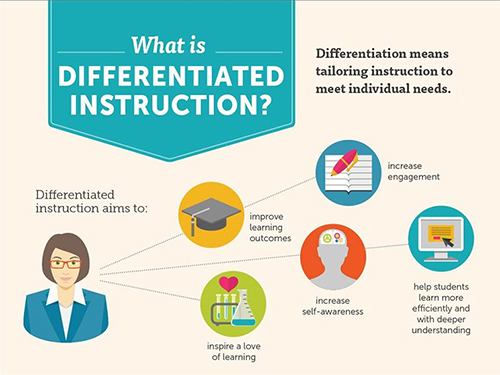
05 April 2021 – Osman Bedel –
Differentiated Instruction: Nurturing Individual Growth in the Classroom
In a diverse classroom, each student possesses unique strengths, challenges, and learning styles. To meet the diverse needs of students, educators employ differentiated instruction, a teaching approach that recognizes and responds to individual differences. Through flexible instructional strategies, varied learning activities, and personalized support, differentiated instruction empowers teachers to tailor their teaching to the specific needs of each student. In this blog post, we will explore the concept of differentiated instruction, its benefits, and how it fosters a dynamic and inclusive learning environment.Understanding Differentiated Instruction
Differentiated instruction is an approach that recognizes that learners vary in readiness, interests, and learning profiles. It involves adapting teaching methods, materials, and assessments to meet the diverse needs of students. Instead of using a one-size-fits-all approach, teachers employ a range of instructional strategies to ensure that all students can access and engage with the curriculum at their level. This approach promotes inclusivity, individual growth, and academic success.
Key Elements of Differentiated Instruction
-
Varied Instructional Strategies: Differentiated instruction utilizes a variety of teaching methods to cater to diverse learning needs. Teachers may employ direct instruction, small group activities, independent projects, hands-on experiences, or technology-enhanced lessons. By offering multiple pathways to learning, students can engage with the content in ways that best suit their learning style and preferences.
-
Flexible Learning Activities: Differentiated instruction provides students with choices and options for learning activities. By offering a menu of options or tiered assignments, students can select tasks that align with their interests, challenge level, or learning goals. This empowers students to take ownership of their learning and fosters a sense of autonomy and engagement.
-
Personalized Support: Differentiated instruction recognizes that students require varying levels of support. Teachers provide targeted interventions, scaffolded instruction, and individualized feedback to meet the unique needs of each student. This may involve additional resources, modifications, or accommodations to ensure that all students can access and succeed in the curriculum.
-
Flexible Grouping: Differentiated instruction incorporates flexible grouping strategies to create learning environments that foster collaboration and peer support. Students may work in small groups, pairs, or individually based on their specific needs. Grouping strategies allow for peer learning, cooperative problem-solving, and targeted support, enhancing both academic and social-emotional growth.
Benefits of Differentiated Instruction
-
Individualized Learning: Differentiated instruction promotes individualized learning experiences tailored to students’ needs, interests, and abilities. By adjusting instruction and providing personalized support, teachers address gaps in knowledge, challenge advanced learners, and ensure that all students can reach their full potential.
-
Increased Engagement: When students are actively engaged in learning activities that align with their interests and abilities, their motivation and interest soar. Differentiated instruction fosters a positive classroom environment where students feel valued, supported, and actively involved in their learning. This engagement leads to a deeper understanding and retention of the material.
-
Inclusivity and Equity: Differentiated instruction ensures that every student has equitable access to quality education. It recognizes and embraces diversity in the classroom, creating a learning environment that celebrates individual strengths and supports areas of growth. By valuing students’ unique backgrounds and abilities, differentiated instruction promotes inclusivity and sets the stage for academic success for all learners.
-
Holistic Development: Differentiated instruction supports the holistic development of students. By addressing individual needs, it nurtures not only academic growth but also social-emotional well-being, self-confidence, and a positive attitude toward learning. Students become active participants in their own education, developing critical thinking, problem-solving, and self-advocacy skills.
-
Lifelong Learning Skills: Differentiated instruction equips students with essential skills for lifelong learning. By promoting self-directed learning, critical thinking, and problem-solving, students develop skills that transcend the classroom and prepare them for future success. Differentiated instruction fosters a growth mindset, resilience, and a love for learning that extends beyond academic achievements.
Differentiated instruction is a powerful teaching approach that acknowledges the diverse needs of students and fosters a culture of inclusivity and personal growth in the classroom. By tailoring instruction, providing varied learning activities, and offering personalized support, educators can create a dynamic learning environment where all students can thrive. As we embrace the uniqueness of each learner, differentiated instruction empowers students to reach their full potential and become lifelong learners.






